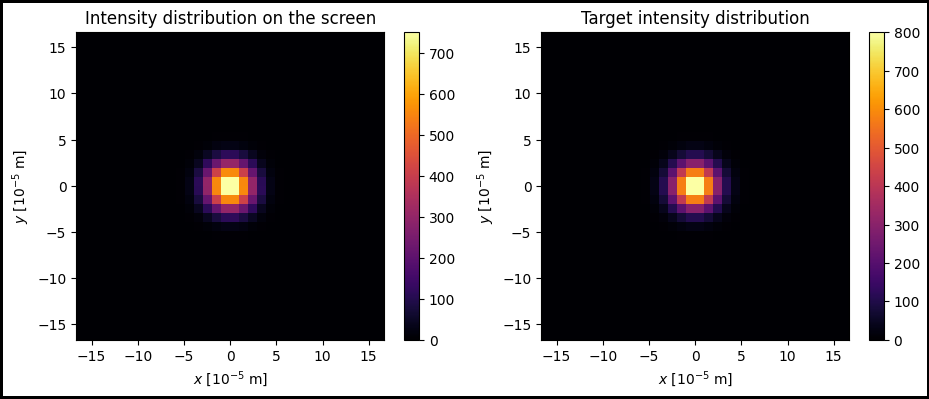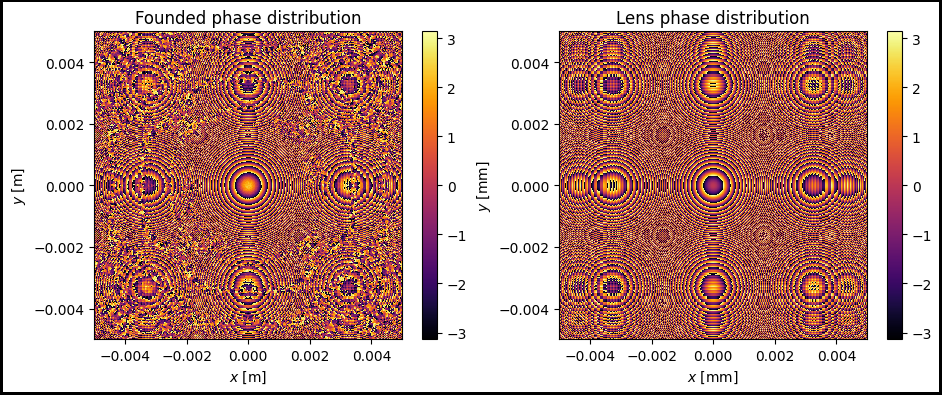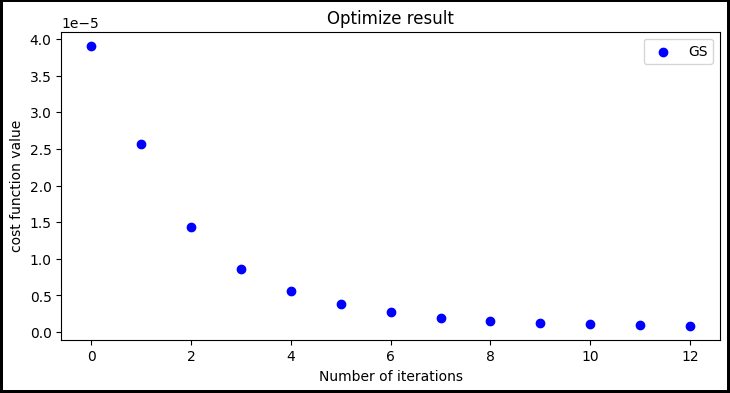[3]:
import torch
import numpy as np
import matplotlib.pyplot as plt
from svetlanna.phase_retrieval_problem import retrieve_phase
from svetlanna.phase_retrieval_problem import SetupLike
from svetlanna import SimulationParameters
from svetlanna import Wavefront
from svetlanna import elements
from svetlanna.units import ureg
Phase retrieval problem: low API example
If it’s necessary to use custom functions that solve direct problem, it’s possible to use SetupLike class from svetlanna.phase_retrieval module.
This class must have .forward() and .reverse() methods which solve direct and reverse propagation problem respectively.
Creating numerical mesh with using SimulationParameters class
[4]:
# optical setup size
lx = 10 * ureg.mm
ly = 10 * ureg.mm
# number of nodes
Nx = 1024
Ny = 1024
# wavelength
wavelength = 1064 * ureg.nm
# focal distance of the lens
focal = 10 * ureg.cm
# radius of the lens
r = 1 * ureg.cm
# distance between the screen and the lens
distance = focal * 1.
# waist radius of the gaussian beam
w0 = 1 * ureg.mm
# creating SimulationParameters exemplar
sim_params = SimulationParameters({
'W': torch.linspace(-lx / 2, lx / 2, Nx),
'H': torch.linspace(-ly / 2, ly / 2, Ny),
'wavelength': wavelength,
})
[5]:
# return 2d-tensors of x and y coordinates
x_grid, y_grid = sim_params.meshgrid(x_axis='W', y_axis='H')
Creating SetupLike object example
[7]:
class PersonalSetup(SetupLike):
def __init__(self, elements: list):
super().__init__()
self.elements = elements
def forward(self, wavefront: Wavefront) -> Wavefront:
for element in self.elements:
wavefront = element.forward(wavefront)
return wavefront
def reverse(self, wavefront: Wavefront) -> Wavefront:
for element in reversed(self.elements):
wavefront = element.reverse(wavefront)
return wavefront
Solving direct problem
[8]:
incident_wavefront = Wavefront.gaussian_beam(
simulation_parameters=sim_params,
waist_radius=w0,
distance=distance
)
source_intensity = incident_wavefront.intensity
lens = elements.ThinLens(
simulation_parameters=sim_params,
focal_length=focal,
radius=r
)
field_after_lens = lens.forward(incident_wavefront=incident_wavefront)
free_space = elements.FreeSpace(
simulation_parameters=sim_params,
distance=distance,
method="AS"
)
output_field = free_space.forward(incident_wavefront=field_after_lens)
target_intensity = output_field.intensity
[10]:
personal_setup = PersonalSetup(elements=[free_space])
Solving phase retrieval problem
[12]:
result_hio = retrieve_phase(
source_intensity=source_intensity,
optical_setup=personal_setup,
target_intensity=target_intensity,
method='HIO',
options= {
'tol': 1e-16,
'maxiter': 12,
'constant_factor': 0.9,
'disp': False
}
)
[13]:
phase_distribution_hio = result_hio.solution
niter_hio = result_hio.number_of_iterations
error_mass_gs = result_hio.cost_func_evolution
Solving direct problem with founded phase profile
[14]:
layer = elements.DiffractiveLayer(
simulation_parameters=sim_params,
mask=phase_distribution_hio
)
field_after_layer = layer.forward(incident_wavefront=incident_wavefront)
output_field_retrieved = free_space.forward(incident_wavefront=field_after_layer)
target_intensity_retrieved = output_field_retrieved.intensity
[15]:
fig, ax = plt.subplots(
1, 2, figsize=(11, 4), edgecolor='black', linewidth=3, frameon=True
)
scale_factor = 1e5
x_grid_scaled = x_grid * scale_factor
y_grid_scaled = y_grid * scale_factor
im1 = ax[0].pcolormesh(x_grid_scaled, y_grid_scaled, target_intensity_retrieved, cmap='inferno')
ax[0].set_aspect('equal')
ax[0].set_title(r'Intensity distribution on the screen')
ax[0].set_xlabel('$x$ [$10^{-5}$ m]')
ax[0].set_ylabel('$y$ [$10^{-5}$ m]')
ax[0].set_xlim(-w0 / 6 * scale_factor, w0 / 6 * scale_factor)
ax[0].set_ylim(-w0 / 6 * scale_factor, w0 / 6 * scale_factor)
fig.colorbar(im1, ax=ax[0])
im2 = ax[1].pcolormesh(x_grid_scaled, y_grid_scaled, target_intensity, cmap='inferno')
ax[1].set_aspect('equal')
ax[1].set_title('Target intensity distribution')
ax[1].set_xlabel('$x$ [$10^{-5}$ m]')
ax[1].set_ylabel('$y$ [$10^{-5}$ m]')
ax[1].set_xlim(-w0 / 6 * scale_factor, w0 / 6 * scale_factor)
ax[1].set_ylim(-w0 / 6 * scale_factor, w0 / 6 * scale_factor)
fig.colorbar(im2, ax=ax[1])
plt.show()

[17]:
fig, ax = plt.subplots(
1, 2, figsize=(11, 4), edgecolor='black', linewidth=3, frameon=True
)
im1 = ax[0].pcolormesh(x_grid, y_grid, phase_distribution_hio, cmap='inferno')
ax[0].set_aspect('equal')
ax[0].set_title('Founded phase distribution')
ax[0].set_xlabel('$x$ [m]')
ax[0].set_ylabel('$y$ [m]')
fig.colorbar(im1)
im2 = ax[1].pcolormesh(x_grid, y_grid, torch.real(torch.log(lens.transmission_function) / 1j), cmap='inferno')
ax[1].set_aspect('equal')
ax[1].set_title('Lens phase distribution')
ax[1].set_xlabel('$x$ [mm]')
ax[1].set_ylabel('$y$ [mm]')
fig.colorbar(im2)
[17]:
<matplotlib.colorbar.Colorbar at 0x1b96a28ae10>

[18]:
fig, ax = plt.subplots(figsize=(8.5, 4), edgecolor='black', linewidth=3, frameon=True
)
ax.set_title(r'Optimize result')
ax.set_xlabel('Number of iterations')
ax.set_ylabel('cost function value')
n_hio = np.arange(0, niter_hio+1)
ax.scatter(n_hio, error_mass_gs, label='GS', color='blue')
ax.legend()
[18]:
<matplotlib.legend.Legend at 0x1b96af51110>
